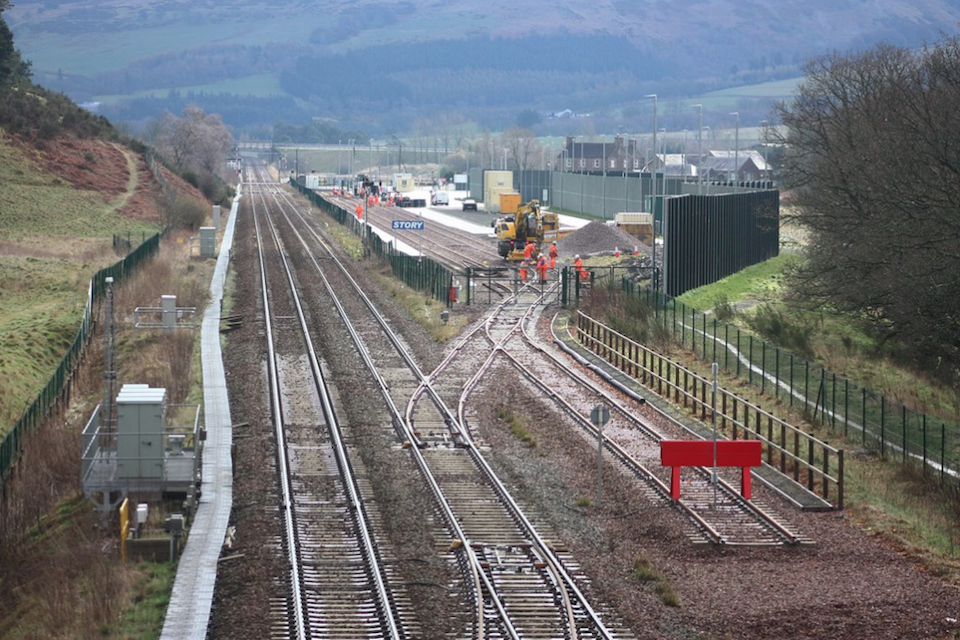Freight flows for Highland Spring water

Despite a tide of challenges, Highland Spring mineral water has finally inaugurated their much-anticipated rail freight facility. The terminal at their headquarters and bottling plant in Blackford, Scotland, has dispatched its first train in front of an invited VIP audience, including Scotland’s senior politician, First Minister Nicola Sturgeon.
Scotland’s first corporate dedicated rail freight facility in over a decade has opened, adjacent to the main line between Stirling and Perth. It has taken almost a decade for the Highland Spring bottling plant terminal to be commissioned. Observers in government, railway management and Scottish industry are all looking on and considering where might be next.
Long-held net-zero ambition
The development is a major milestone for Highland Spring, the UK’s leading producer of natural source waters, and also a significant development for rail freight facilitation in Scotland and the wider UK. For the company, the terminal is the realisation of a long-held ambition to match their distribution chain to their overall corporate ambition to reach net zero operations by 2040.
The new facility, adjacent to the company’s main bottling plant in Blackford, has been planned in partnership with Transport Scotland, Network Rail, and the Scottish government. Highland Spring expects to move around 200 million litres of bottled water per annum by rail, representing forty per cent of total output. That will offer long-term environmental benefits to the community, and by removing 8,000 heavy goods vehicle movements from the road, saving 3,200 tonnes of C02 every year. It’s no irony that most of that carbon dioxide is injected into their sparkling drinks.
Freight Facilities Grant scheme
“Getting the Highland Spring rail freight facility to the point of opening and operating has been a complex task, and everyone involved should be immensely proud of their achievements”, First Minister Nicola Sturgeon told guests at the opening. She went on to acknowledge the contribution of the infrastructure management agency, which works in partnership with her government’s own Transport Scotland. “Network Rail played a key role in developing the infrastructure to support this project. Rail freight is intrinsic to the Scottish economy; it supports the supply chain, serves a broad range of sectors, and is good for society and our environment.”
The Scottish government has invested 4.47 million pounds (5.32 million euros) in the twin-siding project. The funding comes through the Freight Facilities Grant scheme, promoted by the Scottish government to encourage modal shift away from road transport. “Removing more than ten million lorry miles from Scotland’s roads in the first ten years of operation will go a long way to improving the environment and lives of those close by as well as helping the country as a whole achieve net zero”, said Nicola Sturgeon. “I am confident other businesses will now follow suit.”
Rail freight the primary logistics choice
“The opening of this new facility is an exciting and important milestone for rail freight in Scotland”, said Alex Hynes, Managing Director, Scotland’s Railway, who retained his position after the passenger franchise was taken into public ownership earlier this year. “[The Highland Spring terminal is] an excellent example of the public and private sectors working closely with the government to fight climate change head-on. To achieve net zero, we are working hard to ensure that rail freight becomes the primary logistics choice for businesses in Scotland by 2035.”

To achieve Hynes’ target, many more facilities like Blackford would have to come on line. However, there is no shortage of candidates. Timber operations have already been experimenting with rail, and the industrial neighbours of the new Levenmouth line are being courted for more bottled produce by rail. As might be more readily associated with Scotland, that’s a whisky distillery.
The Scottish government has invested 4.47 million pounds (5.32 million euros) in the twin-siding project. The funding comes through the Freight Facilities Grant scheme, promoted by the Scottish government to encourage modal shift away from road transport. “Removing more than ten million lorry miles from Scotland’s roads in the first ten years of operation will go a long way to improving the environment and lives of those close by as well as helping the country as a whole achieve net zero”, said Nicola Sturgeon. “I am confident other businesses will now follow suit.”
Rail freight the primary logistics choice
“The opening of this new facility is an exciting and important milestone for rail freight in Scotland”, said Alex Hynes, Managing Director, Scotland’s Railway, who retained his position after the passenger franchise was taken into public ownership earlier this year. “[The Highland Spring terminal is] an excellent example of the public and private sectors working closely with the government to fight climate change head-on. To achieve net zero, we are working hard to ensure that rail freight becomes the primary logistics choice for businesses in Scotland by 2035.”
The facility will deliver water containers from Highland Spring production in Blackford to their external warehouse in Daventry daily.
To achieve Hynes’ target, many more facilities like Blackford would have to come on line. However, there is no shortage of candidates. Timber operations have already been experimenting with rail, and the industrial neighbours of the new Levenmouth line are being courted for more bottled produce by rail. As might be more readily associated with Scotland, that’s a whisky distillery.
You just read one of our premium articles free of charge
Want full access? Take advantage of our exclusive offer





